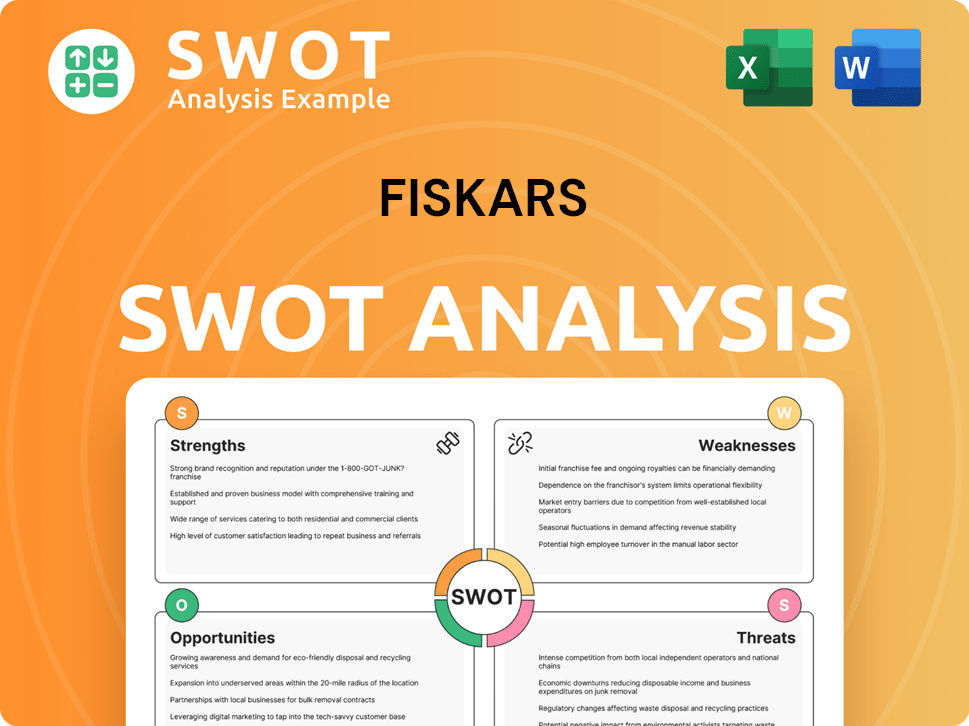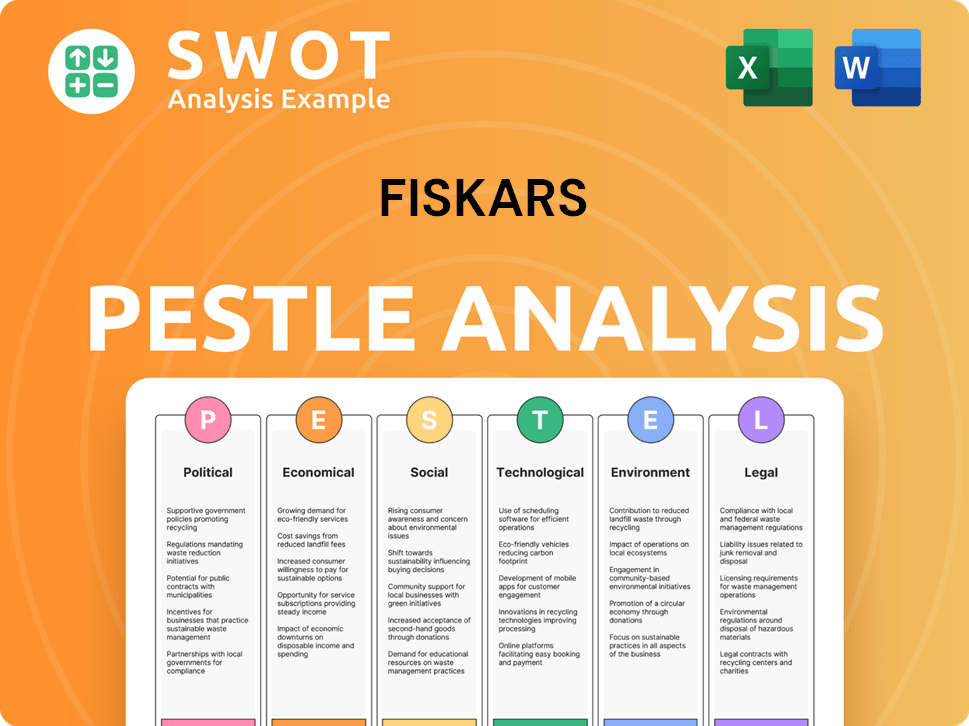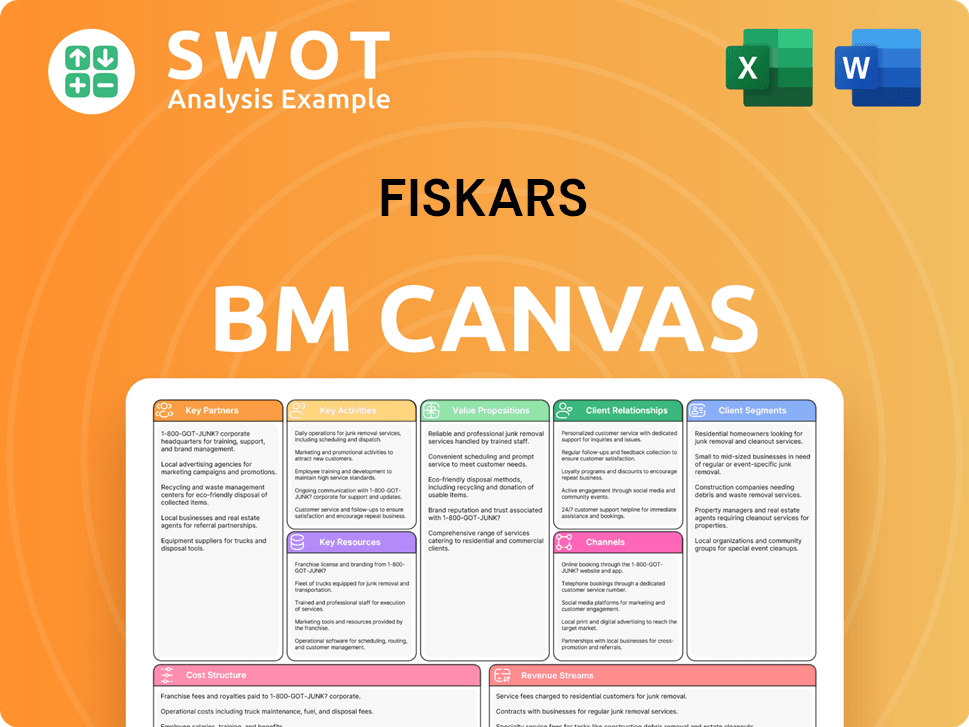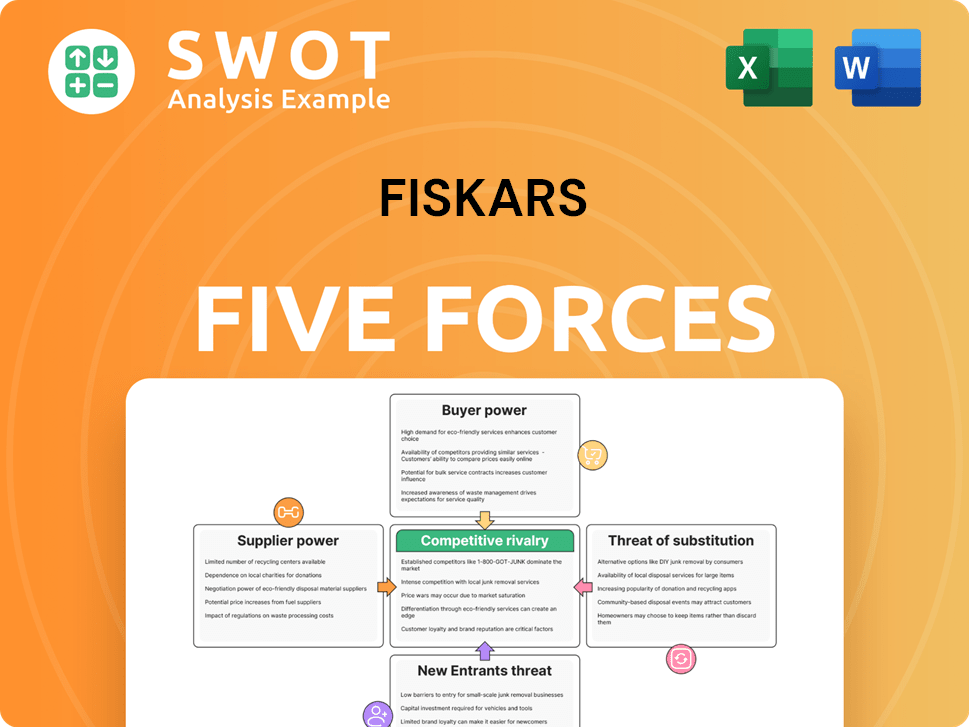Fiskars Bundle
How Does Fiskars, a Centuries-Old Company, Stay Ahead?
From its humble beginnings in 1649, Fiskars has transformed from an ironworks to a global powerhouse, but how does it maintain its competitive edge? The company's recent strategic shift to separate its business areas underscores a commitment to innovation and growth. This deep dive explores the Fiskars SWOT Analysis, sales and marketing strategies that drive its success.

This analysis will dissect Fiskars' sales strategy, encompassing its diverse distribution channels and how it reaches its target audience. We'll examine the Fiskars marketing strategy, including its digital marketing strategy and social media strategy, to understand how the company builds and maintains its brand. Furthermore, we'll explore Fiskars' brand positioning strategy and key marketing campaign examples, revealing how it strategically navigates the consumer goods market and maintains its market share.
How Does Fiskars Reach Its Customers?
The sales channels employed by the company, a key element of its overall Fiskars company strategy, are designed to reach a global customer base through a combination of online and offline methods. This approach is a critical part of the Fiskars sales strategy, ensuring that products are accessible to consumers through various touchpoints.
In 2024, the company's sales strategy heavily relied on wholesale channels, which accounted for approximately 70% of total sales. This significant portion of revenue underscores the importance of maintaining strong relationships with major retailers and wholesale partners. The company's Fiskars marketing strategy also focuses on direct-to-consumer (DTC) sales as a strategic growth area.
DTC sales represented 28% of the company's total sales in 2024. This includes its own stores and e-commerce platforms. The company's investment in IT and supply chain projects further supports its omnichannel integration and digital expansion, particularly in the DTC segment. This strategy is a key part of the company's overall approach to the market.
Wholesale remains the largest sales channel, contributing significantly to the company's revenue. This channel primarily involves sales through major retailers' physical stores and their e-commerce platforms. The company focuses on building and maintaining strong relationships with its wholesale partners to ensure product availability and market reach.
DTC sales are a crucial growth driver, encompassing the company's own stores and e-commerce platforms. In Q1 2025, comparable DTC sales increased by 9%, demonstrating the effectiveness of this channel. The acquisition of Georg Jensen in October 2023 further boosted the DTC presence, with over 50% of its sales coming from its own retail and e-commerce channels.
The company also utilizes other channels, such as B2B sales and hospitality sales, to diversify its market reach. These smaller indirect channels complement the primary wholesale and DTC channels. The evolution of these channels reflects the company's strategic shift towards omnichannel integration and increased digital adoption.
In Q1 2025, the DTC channel demonstrated strong performance, with both the own retail network and e-commerce increasing by 9% and 10%, respectively. This growth highlights the success of the company's efforts in expanding its direct customer engagement. Business Area Vita's brands saw 50% of its net sales in 2024 coming from DTC channels.
The company's sales channel strategy reflects a broader move towards omnichannel integration and increased digital adoption. This is supported by ongoing investments in IT and supply chain projects. The company's approach to the market is detailed in the Growth Strategy of Fiskars.
- Emphasis on DTC channels to enhance customer engagement and control.
- Continued investment in digital infrastructure to support e-commerce growth.
- Strategic acquisitions to strengthen DTC presence and brand portfolio.
- Focus on building strong relationships with wholesale partners.
Fiskars SWOT Analysis
- Complete SWOT Breakdown
- Fully Customizable
- Editable in Excel & Word
- Professional Formatting
- Investor-Ready Format

What Marketing Tactics Does Fiskars Use?
The company, known for its diverse portfolio of brands, employs a multifaceted marketing approach. This strategy aims to boost brand awareness, generate leads, and ultimately drive sales. The focus is on reaching customers through various channels, with digital tactics playing a crucial role.
Digital channels are central to the company's strategy, encompassing content marketing, SEO, paid advertising, email marketing, influencer partnerships, and social media. The company actively engages with customers directly through channels like email and SMS. Investments in digitalization and data-driven strategies are integral to enhancing its global market position.
The company also utilizes traditional media and events where relevant for specific brands and target audiences. The transition to SaaS-based Direct-to-Consumer services indicates continuous innovation in its marketing technology. The company has focused on strengthening its gross margin and maintaining prudent cost management, which has contributed to improved profitability despite challenging market conditions.
The company's digital marketing strategy includes content marketing, SEO, and paid advertising. It also utilizes email marketing, influencer partnerships, and social media to reach its target audience. This comprehensive approach is designed to increase brand visibility and drive sales.
The company actively communicates directly with customers across various channels. This includes email and SMS, which allows for personalized messaging and targeted campaigns. Direct communication enhances customer engagement and supports the overall Brief History of Fiskars.
Investments in digitalization and becoming more data-driven are integral to the company's growth strategy. This approach supports data-driven marketing and customer segmentation. Ongoing IT and retail projects are crucial for this strategy.
While digital channels are important, the company also uses traditional media and events. This approach is tailored to specific brands and target audiences. This helps to maintain a broad reach and cater to diverse customer preferences.
The company is transitioning from its existing digital platform to SaaS-based Direct-to-Consumer services. This indicates continuous innovation in its marketing technology. This move aims to improve efficiency and enhance customer experience.
In Q1 2025, the company's gross margin was 47.5%. The company has focused on strengthening its gross margin and maintaining prudent cost management. This has contributed to improved profitability despite challenging market conditions.
The company's marketing strategy is a blend of digital and traditional methods, supported by data-driven insights and technological advancements. This approach is designed to maximize market share and enhance profitability. The company's focus on customer engagement and cost management further strengthens its position in the market.
- Digital Marketing: Content marketing, SEO, paid advertising, email marketing, social media, and influencer partnerships.
- Customer Engagement: Direct communication via email and SMS.
- Data-Driven Decisions: Utilizing data to support marketing efforts and customer segmentation.
- Technological Innovation: Transitioning to SaaS-based Direct-to-Consumer services.
- Financial Management: Strengthening gross margin and prudent cost management.
Fiskars PESTLE Analysis
- Covers All 6 PESTLE Categories
- No Research Needed – Save Hours of Work
- Built by Experts, Trusted by Consultants
- Instant Download, Ready to Use
- 100% Editable, Fully Customizable

How Is Fiskars Positioned in the Market?
The brand positioning of the company, a global leader in consumer goods, revolves around the core message: 'Pioneering design to make the everyday extraordinary.' This strategy emphasizes timelessness, functionality, and beauty, coupled with a commitment to innovation and sustainable growth. The company's approach to brand positioning is multifaceted, catering to diverse consumer segments through its various brands.
The company differentiates itself through its rich heritage, spanning over 375 years, which signifies enduring quality and craftsmanship. This history is a cornerstone of its brand identity, fostering trust and recognition among consumers worldwide. The company's brand portfolio includes a variety of products, each tailored to appeal to specific target audiences, ensuring a broad market reach.
The company's commitment to sustainability is evident through its high ratings from EcoVadis and CDP in 2024. This commitment, along with targets such as a majority of net sales coming from circular products and services by 2030, reinforces its brand consistency and responsiveness to consumer sentiment. This focus on sustainability and innovation is a key element of the company's overall Growth Strategy of Fiskars, enhancing its brand image and appeal.
The company's brand identity is built on a foundation of heritage, quality, and innovation. The Fiskars brand itself is associated with gardening, outdoor, scissors, crafting, and cooking categories. This identity is reinforced through consistent messaging and product design.
Business Area Vita focuses on premium and luxury products, including tableware, drinkware, jewelry, and interior items. Brands like Georg Jensen, Royal Copenhagen, and Wedgwood are positioned in the high-end market. This segment has a strong presence in direct-to-consumer channels.
The company achieved a Platinum level sustainability rating from EcoVadis in 2024, placing it among the top 1% of companies assessed in its industry. The company also received an A- rating in CDP's 2024 Climate Change questionnaire, highlighting its commitment to environmental responsibility.
The company's target audience is diverse, spanning various demographics and lifestyle preferences. The brand caters to consumers who value quality, design, and sustainability across different product categories. The company's approach to the Fiskars sales strategy involves understanding and meeting the needs of its varied customer base.
The company's brand positioning strategy is a blend of heritage, innovation, and sustainability. This approach is designed to resonate with a broad audience while maintaining a focus on premium quality and design. Understanding the company's marketing strategy is essential for appreciating its overall success.
- Heritage and Craftsmanship: Emphasizing a history of over 375 years.
- Innovation and Design: Focusing on timeless, purposeful, and functional beauty.
- Sustainability: Achieving high ratings from EcoVadis and CDP.
- Targeted Brand Approach: Tailoring brand identities to specific consumer segments.
- Direct-to-Consumer Channels: Strengthening presence in direct sales.
Fiskars Business Model Canvas
- Complete 9-Block Business Model Canvas
- Effortlessly Communicate Your Business Strategy
- Investor-Ready BMC Format
- 100% Editable and Customizable
- Clear and Structured Layout

What Are Fiskars’s Most Notable Campaigns?
Fiskars Group's Fiskars sales strategy and Fiskars marketing strategy are centered on strategic campaigns designed to build its Fiskars brand and drive growth across its diverse portfolio of Fiskars products. While specific details of individual campaign performance metrics are not extensively publicized, the company's overall approach highlights key areas of focus. These campaigns are crucial for achieving the company's goals in a competitive market.
A significant aspect of their strategy involves expanding their Direct-to-Consumer (DTC) channels. This focus has led to a notable increase in sales. Another critical component of the Fiskars company strategy involves strategic acquisitions and geographic expansion. The company adapts its strategies based on regional economic conditions, as seen in its approach to the U.S. and China markets.
Fiskars Group's strategic campaigns are pivotal in shaping its brands and boosting growth. To understand more about their revenue streams, consider reading the article about Revenue Streams & Business Model of Fiskars.
The company emphasizes Direct-to-Consumer (DTC) growth, which saw a 9% increase in comparable sales in Q1 2025. This indicates successful campaigns driving traffic and conversions through their retail network and e-commerce platforms. This shows a strong focus on digital marketing strategies.
The acquisition of Georg Jensen in late 2023 was a strategic move to accelerate luxury brand growth, demonstrating a clear campaign objective of expanding market share in the luxury segment. This focus is part of their overall Fiskars market analysis.
In Q1 2025, comparable net sales in the U.S. increased by 6%, driven by distribution gains for the Fiskars brand, suggesting successful campaigns aimed at expanding reach within this key market. This highlights their Fiskars sales and marketing plan.
Comparable net sales in China decreased by 7% in Q1 2025 due to low consumer confidence, indicating a challenging market where campaigns may be focused on maintaining brand presence and adapting to economic conditions. This reflects the need for a flexible Fiskars competitive analysis.
Business Area Fiskars saw successful campaigns in Europe, particularly in Germany, contributing to a 3% growth in comparable net sales in Q1 2025. This demonstrates the effectiveness of their Fiskars product distribution strategy in the region.
Good growth was noted for Royal Copenhagen and Moomin Arabia brands in Q4 2024, driven by strong commercial execution. This showcases the importance of effective Fiskars brand positioning strategy.
The company tailors its campaigns to specific markets, as seen in the differing approaches to the U.S. and China. This approach is critical for reaching their Fiskars target audience effectively.
The emphasis on DTC growth indicates a strong Fiskars digital marketing strategy. This includes leveraging e-commerce platforms and social media to drive sales and improve customer relationships.
The company's ability to adapt to changing market conditions, such as the challenges in China, is crucial for long-term success. This adaptability is key for their Fiskars sales performance.
The acquisition of Georg Jensen is a prime example of how Fiskars uses strategic acquisitions to expand its brand portfolio and reach new customer segments. This strategy directly impacts their Fiskars market share.
Fiskars Porter's Five Forces Analysis
- Covers All 5 Competitive Forces in Detail
- Structured for Consultants, Students, and Founders
- 100% Editable in Microsoft Word & Excel
- Instant Digital Download – Use Immediately
- Compatible with Mac & PC – Fully Unlocked

Related Blogs
- What are Mission Vision & Core Values of Fiskars Company?
- What is Competitive Landscape of Fiskars Company?
- What is Growth Strategy and Future Prospects of Fiskars Company?
- How Does Fiskars Company Work?
- What is Brief History of Fiskars Company?
- Who Owns Fiskars Company?
- What is Customer Demographics and Target Market of Fiskars Company?
Disclaimer
All information, articles, and product details provided on this website are for general informational and educational purposes only. We do not claim any ownership over, nor do we intend to infringe upon, any trademarks, copyrights, logos, brand names, or other intellectual property mentioned or depicted on this site. Such intellectual property remains the property of its respective owners, and any references here are made solely for identification or informational purposes, without implying any affiliation, endorsement, or partnership.
We make no representations or warranties, express or implied, regarding the accuracy, completeness, or suitability of any content or products presented. Nothing on this website should be construed as legal, tax, investment, financial, medical, or other professional advice. In addition, no part of this site—including articles or product references—constitutes a solicitation, recommendation, endorsement, advertisement, or offer to buy or sell any securities, franchises, or other financial instruments, particularly in jurisdictions where such activity would be unlawful.
All content is of a general nature and may not address the specific circumstances of any individual or entity. It is not a substitute for professional advice or services. Any actions you take based on the information provided here are strictly at your own risk. You accept full responsibility for any decisions or outcomes arising from your use of this website and agree to release us from any liability in connection with your use of, or reliance upon, the content or products found herein.